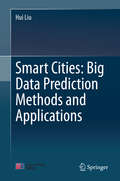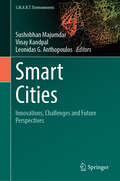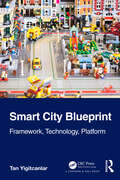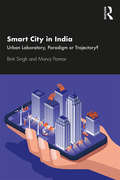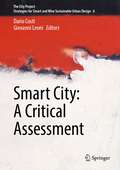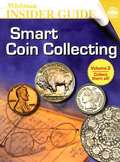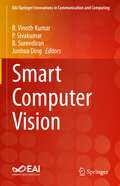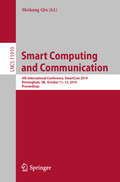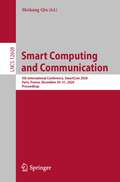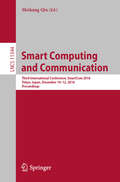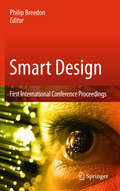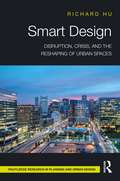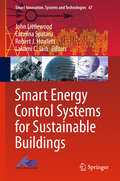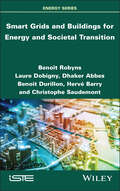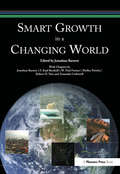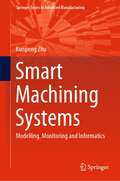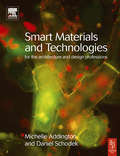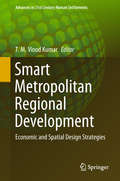- Table View
- List View
Smart Cities: A Spatialised Intelligence (Architectural Design Primer)
by Antoine PiconAs cities compete globally, the Smart City has been touted as the important new strategic driver for regeneration and growth. Smart Cities are employing information and communication technologies in the quest for sustainable economic development and the fostering of new forms of collective life. This has made the Smart City an essential focus for engineers, architects, urban designers, urban planners, and politicians, as well as businesses such as CISCO, IBM and Siemens. Despite its broad appeal, few comprehensive books have been devoted to the subject so far, and even fewer have tried to relate it to cultural issues and to assume a truly critical stance by trying to decipher its consequences on urban space and experience. This cultural and critical lens is all the more important as the Smart City is as much an ideal permeated by Utopian beliefs as a concrete process of urban transformation. This ideal possesses a strong self-fulfilling character: our cities will become ‘Smart’ because we want them to. This book opens with an examination of the technological reality on which Smart Cities are built, from the chips and sensors that enable us to monitor what happens within the infrastructure to the smartphones that connect individuals. Through these technologies, the urban space appears as activated, almost sentient. This activation generates two contrasting visions: on the one hand, a neo-cybernetic ambition to steer the city in the most efficient way; and on the other, a more bottom-up, participative approach in which empowered individuals invent new modes of cooperation. A thorough analysis of these two trends reveals them to be complementary. The Smart City of the near future will result from their mutual adjustment. In this process, urban space plays a decisive role. Smart Cities are contemporary with a ‘spatial turn’ of the digital. Based on key technological developments like geo-localisation and augmented reality, the rising importance of space explains the strategic role of mapping in the evolution of the urban experience. Throughout this exploration of some of the key dimensions of the Smart City, this book constantly moves from the technological to the spatial as well as from a critical assessment of existing experiments to speculations on the rise of a new form of collective intelligence. In the future, cities will become smarter in a much more literal way than what is often currently assumed.
Smart Cities: Big Data Prediction Methods and Applications
by Hui LiuSmart Cities: Big Data Prediction Methods and Applications is the first reference to provide a comprehensive overview of smart cities with the latest big data predicting techniques. This timely book discusses big data forecasting for smart cities. It introduces big data forecasting techniques for the key aspects (e.g., traffic, environment, building energy, green grid, etc.) of smart cities, and explores three key areas that can be improved using big data prediction: grid energy, road traffic networks and environmental health in smart cities. The big data prediction methods proposed in this book are highly significant in terms of the planning, construction, management, control and development of green and smart cities. Including numerous case studies to explain each method and model, this easy-to-understand book appeals to scientists, engineers, college students, postgraduates, teachers and managers from various fields of artificial intelligence, smart cities, smart grid, intelligent traffic systems, intelligent environments and big data computing.
Smart Cities: Governing, Modelling and Analysing the Transition
by Mark DeakinSmart city development has emerged a major issue over the past 5 years. Since the launch of IBM’s Smart Planet and CISCO’s Smart Cities and Communities programmes, their potential to deliver on global sustainable development targets have captured the public’s attention. However, despite this growing interest in the development of smart cities, little has as yet been published that either sets out the state-of-the-art, or which offers a less than subjective, arm’s length and dispassionate account of their potential contribution. This book brings together cutting edge research and the findings from technical development projects from leading authorities within the field to capture the transition to smart cities. It explores what is understood about smart cities, playing particular attention on the governance, modelling and analysis of the transition that smart cities seek to represent. In paving the way for such a representation, the book begins to account for the social capital of smart communities and begins the task of modelling their embedded intelligence through an analysis of what the "embedded intelligence of smart cities" contributes to the sustainability of urban development. This innovative book offers an interdisciplinary perspective and shall be of interest to researchers, policy analysts and technical experts involved in and responsible for the planning, development and design of smart cities. It will also be of particular value to final year undergraduate and postgraduate students interested in Geography, Architecture and Planning.
Smart Cities: Innovations, Challenges and Future Perspectives (S.M.A.R.T. Environments)
by Leonidas G. Anthopoulos Sushobhan Majumdar Vinay KandpalThis book aims to integrate new technologies and adaptation tools into the process of smart city planning. It also emphasizes the value and importance of modern technologies such as IoT and data science as a smart technology for the formation of a smart city. The authors believe that various technologies in a smart city will reduce all the problems for the sustainable growth and future prospects of the city. The first section of this book discusses the innovation of new technologies (AI, data science, block chain, etc.) that has flourished in recent decades which will make the city smarter. This section also describes that block chain and IoT (Internet of Things) are two transformative technologies that can greatly impact smart cities by enhancing security, improving transparency, and enabling efficient management of resources. The second section of the book explains about the uses of AI tools and smart technologies (like waste management, public safety and security) for the development and management of smart cities. This chapter also describes AI-powered systems that are integrated into smart buildings to optimize energy usage, enhance occupant comfort, and improve building management. These systems can adjust lighting and HVAC settings based on occupancy, learn user preferences, and provide personalized energy efficiency recommendations. The third portion of the book investigates the recent challenges and barriers of smart city that have been faced by the smart cities in the recent decades. This section also describes various challenges and barriers for the implementation of IoT sensor, AI technologies, etc., for the formation of a smart city. The future prospects of a smart city are the main theme of the last chapter. In this section, an attempt has been made about the future vision and outlook of the smart city. This chapter also describes different approaches (like smart grid, societal smart city, smart city model, etc.) for the future planning and management of the city.
Smart Cities: Lock-in, Path-dependence and Non-linearity of Digitalization and Smartification (Advances In Science, Technology And Innovation Ser.)
by Anna Visvizi Hanna Godlewska-MajkowskaThis book seeks to identify and to examine factors and mechanisms underlying the growth and development of smart cities.It is commonplace to discuss smart cities through the lens of advances in ICT. The resulting overemphasis on what is technologically possible downplays what is politically, socially and economically feasible. This book, by analysing the smart city through a variety of perspectives, offers a more comprehensive insight into and understanding of the complex and the open-ended nature of the growth and development of a smart city. A solid conceptual framework is developed and employed throughout the chapters, and a selection of case studies from Europe, Asia, and the Arab Peninsula grants the readers a hands-on perspective of the matters discussed.The chapters included in this book address a set of questions, including: How do the twin-processes of digitalization and smartification unfold in the context of the smart city agenda? How do these processes relate to the concepts of smart city 1.0, 2.0., 3.0. and 4.0? In which ways have the spatial aspects of city functioning been influenced by the intrusion of ICT? In which ways do the same processes contribute to the attainment of the UN Sustainable Development Goals (SDGs)? What are the implications of smartification and the emergence of smart organizations (public, private, and voluntary) for the spatial development of smart cities? Do ICT and its application in the city space boost the processes of revitalization and how does ICT influence the process of gentrification? To what extent and how does the intrusion of ICT-enhanced tools and applications in the city space impact on a city’s relationship with its broader territorially defined context? Are the administrative borders and divisions inherent in the fabric of a city becoming less/more porous? How should urban sprawl be conceived in the context of the smart city debate? This book will have a broad appeal to academics, students, and policy makers with interests in urban planning, sustainable development, cities, economics, technology, sociology, urban studies, digitalization, SDGs, wellbeing, and resilience.
Smart Cities—Opportunities and Challenges: Select Proceedings of ICSC 2019 (Lecture Notes in Civil Engineering #58)
by Sirajuddin Ahmed S. M. Abbas Hina ZiaThis book comprises select proceedings of the International Conference on Smart Cities: Opportunities and Challenges (ICSC 2019). The book contains chapters based on urban planning and design, policies and financial management, environment, energy, transportation, smart materials, sustainable development, information technologies, data management and urban sociology reflecting the major themes of the conference. The contents focus on current research towards improved governance and efficient management of infrastructure such as water, energy, transportation and housing for sustainable development, economic growth, and improved quality of life, especially for developing nations. This book will be useful for academicians, researchers, and policy makers interested in designing, developing, planning, managing, and maintaining smart cities.
Smart City Blueprint: Framework, Technology, Platform
by Tan YigitcanlarThe smart city movement, during the last decade and a half, advocated the built environment and digital technology convergence with the backing of institutional capital and government support. The commitment of a significant number of local governments across the globe, in terms of official smart city policies and initiatives, along with the constant push of global technology giants, has reinforced the popularity of this movement. This two-volume treatment on smart cities thoroughly explores and sheds light on the prominent elements of the smart city phenomenon and generates a smart city blueprint. This first volume, with its 12 chapters, provides a sound understanding on the key foundations and growth directions of smart city frameworks, technologies, and platforms, with theoretical expansions, practical implications, and real-world case study lessons. The second companion volume offers sophisticated perspectives on the key foundations and directions of smart city policies, communities, and urban futures, with theoretical expansions, practical implications, and real-world case study lessons. This book is an invaluable reference source for urban policymakers, managers, planners, practitioners, and many others, particularly to benefit from it when tackling key urban and societal issues and planning for and delivering smart city solutions. Moreover, the book is also a rich and important repository for scholars and research and undergraduate students as it communicates the complex smart city phenomenon in an easy to digest form, by providing both the big picture view and specifics of each component of that view. It also appeals to local government agencies and smart city practitioners.
Smart City in India: Urban Laboratory, Paradigm or Trajectory?
by Binti Singh Manoj ParmarThis book is a critical reflection on the Smart City Mission in India. Drawing on ethnographic data from across Indian cities, this volume assesses the transformative possibilities and limitations of the program. It examines the ten core infrastructural elements that make up a city, including water, electricity, waste, mobility, housing, environment, health, and education, and lays down the basic tenets of urban policy in India. The volume underlines the need to recognize liminal spaces and the plans to make the ‘smart city’ an inclusive one. The authors also look at maintaining a link between the older heritage of a city and the emerging urban space. This volume will be of great interest to planners, urbanists, and policymakers, as well as scholars and researchers of urban studies and planning, architecture, and sociology and social anthropology.
Smart City: A Critical Assessment (The City Project #6)
by Giovanni Leoni Dario CostiThis contributed volume reports on a multidisciplinary collective work on the topic of Smart City, merging scientific reflections and operational issues. Here, current Smart Cities concepts are subjected to criticism, while the related terminology has been updated to contemplate a model of urban development capable of integrating technical and humanistic culture by fostering an open dialogue between different stakeholders. Upon an introduction to the state of the art, this book presents a glossary of definitions and concepts around the contemporary city, and five interviews with researchers and scholars of different background. The last chapter summarizes current challenges in designing the city of the future, highlighting new research directions in home-infrastructure, small smart city, energy transition, connectivity, digitalization and autonomous and connected mobility.Written by the members of the Scientific Committee of the Smart City 4.0 Sustainable LAB ResearchLaboratory, an inter-university network including research groups from the University of Parma, University of Modena and Reggio Emilia, University of Bologna, University of Ferrara, the Polytechnic University of Milan, and the Catholic University of Milan with its Piacenza campus, this book offers a source of inspiration for other researchers and stakeholders, and it is intended to foster collaborations between different stakeholders - and possibly countries – to develop future cities that are wise, green, sustainable and inclusive.
Smart Coin Collecting
by Whitman PublishingInformation on buying, selling and collecting all sorts of coins.
Smart Computer Vision (EAI/Springer Innovations in Communication and Computing)
by P. Sivakumar B. Vinoth Kumar B. Surendiran Junhua DingThis book addresses and disseminates research and development in the applications of intelligent techniques for computer vision, the field that works on enabling computers to see, identify, and process images in the same way that human vision does, and then providing appropriate output. The book provides contributions which include theory, case studies, and intelligent techniques pertaining to computer vision applications. The book helps readers grasp the essence of the recent advances in this complex field. The audience includes researchers, professionals, practitioners, and students from academia and industry who work in this interdisciplinary field. The authors aim to inspire future research both from theoretical and practical viewpoints to spur further advances in the field.
Smart Computing and Communication: 4th International Conference, SmartCom 2019, Birmingham, UK, October 11–13, 2019, Proceedings (Lecture Notes in Computer Science #11910)
by Meikang QiuThis book constitutes the refereed proceedings of the 4th International Conference on Smart Computing and Communications, SmartCom 2019, held in Birmingham, UK, in October 2019. The 40 papers presented in this volume were carefully reviewed and selected from 286 submissions. They focus on both smart computing and communications fields and aimed to collect recent academic work to improve the research and practical application in the field.
Smart Computing and Communication: 5th International Conference, SmartCom 2020, Paris, France, December 29–31, 2020, Proceedings (Lecture Notes in Computer Science #12608)
by Meikang QiuThis book constitutes the proceedings of the 5th International Conference on Smart Computing and Communication, SmartCom 2020, which took place in Paris, France, during December 29-31, 2020.The 30 papers included in this book were carefully reviewed and selected from 162 submissions. The scope of SmartCom 2020 was broad, from smart data to smart communications, from smart cloud computing to smart security. The conference gathered all high-quality research/industrial papers related to smart computing and communications and aimed at proposing a reference guideline for further research.
Smart Computing and Communication: Third International Conference, SmartCom 2018, Tokyo, Japan, December 10–12, 2018, Proceedings (Lecture Notes in Computer Science #11344)
by Meikang QiuThis book constitutes the refereed proceedings of the Third International Conference on Smart Computing and Communications, SmartCom 2018, held in Tokyo, Japan, in December 2018. The 45 papers presented in this volume were carefully reviewed and selected from 305 submissions. They focus on topics from smart data to smart communications, as well as smart cloud computing to smart security.
Smart Design
by Philip BreedonGood product designs merge materials, technology and hardware into a unified user experience; one where the technology recedes into the background and people benefit from the capabilities and experiences available. By focusing on functional gain, critical awareness and emotive connection, even the most multifaceted and complex technology can be made to feel straightforward and become an integral part of daily life. Researchers, designers and developers must understand how to progress or appropriate the right technical and human knowledge to inform their innovations. The 1st International Smart Design conference provides a timely forum and brings together researchers and practitioners to discuss issues, identify challenges and future directions, and share their R&D findings and experiences in the areas of design, materials and technology. This proceedings of the 1st Smart Design conference held at Nottingham Trent University in November 2011 includes summaries of the talks given on topics ranging from intelligent textiles design to pharmaceutical packaging to the impact of social and emotional factors on design choices with the aim of informing and inspiring future application and development of smart design.
Smart Design: Disruption, Crisis, and the Reshaping of Urban Spaces
by Richard HuThis book tackles the emerging smart urbanism to advance a new way of urban thinking and to explore a new design approach. It unravels several urban transformations in dualities: economic relationality and centrality, technological flattening and polarisation, and spatial division and fusion. These dualities are interdependent; concurrent, coexisting, and contradictory, they are jointly disrupting and reshaping many aspects of contemporary cities and spaces. The book draws on a suite of international studies, experiences, and observations, including case studies in Beijing, Singapore, and Boston, to reveal how these processes are impacting urban design, development, and policy approaches. The COVID-19 pandemic has accelerated many changes already in motion, and provides an extreme circumstance for reflecting on and imagining urban spaces. These analyses, thoughts, and visions inform an urban imaginary of smart design that incorporates change, flexibility, collaboration, and experimentation, which together forge a paradigm of urban thinking. This paradigm builds upon the modernist and postmodernist urban design traditions and extends them in new directions, responding to and anticipating a changing urban environment. The book proposes a smart design manifesto to stimulate thought, trigger debate, and, hopefully, influence a new generation of urban thinkers and smart designers. It will be of interest to scholars, students, and practitioners in the fields of urban design, planning, architecture, urban development, and urban studies.
Smart Energy Control Systems for Sustainable Buildings
by Lakhmi C. Jain Robert J. Howlett Catalina Spataru John LittlewoodThere is widespread interest in the way that smart energy control systems, such as assessment and monitoring techniques for low carbon, nearly-zero energy and net positive buildings can contribute to a Sustainable future, for current and future generations. There is a turning point on the horizon for the supply of energy from finite resources such as natural gas and oil become less reliable in economic terms and extraction become more challenging, and more unacceptable socially, such as adverse public reaction to 'fracking'. Thus, in 2016 these challenges are having a major influence on the design, optimisation, performance measurements, operation and preservation of: buildings, neighbourhoods, cities, regions, countries and continents. The source and nature of energy, the security of supply and the equity of distribution, the environmental impact of its supply and utilization, are all crucial matters to be addressed by suppliers, consumers, governments, industry, academia, and financial institutions. This book entitled 'Smart Energy Control Systems for Sustainable Buildings' contains eleven chapters written by international experts based on enhanced conference papers presented at the Sustainability and Energy in Buildings International conference series. This book will be of interest to University staff and students; and also industry practioners.
Smart Graphics
by Yaxi Chen Marc Christie Wenrong TanFor centuries, artists and designers have been creating communicative graphics. With the advent of new forms of media, the emergence of paradigms such as ubiquitous computing, and the rapid evolution of interaction devices, there is a continuous cycle of renewal of the technologies and methods to support artists, interaction designers and developers. Developingnewapproachesrequiresanunderstandingofthe fundamentals of perception and cognition as they relate to interaction and communication te- nologies, together with arti?cial intelligence and computer graphics techniques to automate reasoning and enhance cognition. Smart Graphics is in essence an interdisciplinary endeavor and brings together the ?elds of computer graphics, arti?cial intelligence, cognitive science, graphic design and ?ne art. The International Symposium on Smart Graphics 2008 was held on August 27-29 in Rennes, France. It was the ninth event in a series which originally started in 2000 as an American Association for Arti?cial Intelligence Spring Symposium and has taken place every year since then. Due to the high quality of the papers submitted this year, the ProgramCommittee decided to accept 17 fullpapers(insteadoftheusual15),9shortpapersand3systemdemonstrations. The acceptance rate for full papers was 34%. This year's meeting included a discussion as to the nature of the shape, contentandfutureoftheevent. Representativesfromdi?erentcommunitieswere invitedtogivetheiropinions,andtheorganizingcommitteewouldliketowarmly thank them here. Such questions as the ongoing viability of the symposium and theconsequencesofco-locatingSmartGraphicswithotherlargerresearchevents led to interesting debates and have prepared the groundwork for what could be the future of the Smart Graphics conference series.
Smart Graphics: 13th International Symposium, SG 2015, Chengdu, China, August 26-28, 2015, Revised Selected Papers (Lecture Notes in Computer Science #9317)
by Yaxi Chen, Marc Christie and Wenrong TanThis book constitutes the proceedings of the 13th International Symposium on Smart Graphics, SG 2015, held in Chengdu, China, in August 2015. The 17 full and 3 short papers presented in this volume were carefully reviewed and selected from 35 submissions. They are organized in topical sections named: graphics, sketching and visualization, automation and evaluation, image processing, and posters and demo session.
Smart Grids and Buildings for Energy and Societal Transition
by Benoît Robyns Christophe Saudemont Hervé Barry Dhaker Abbes Laure Dobigny Benoit DurillonThis book presents interdisciplinary approaches to help buildings, electrical energy networks and their users contribute to the energy and societal transition. Smart Grids and Buildings for Energy and Societal Transition examines the technologies, uses and imaginaries involved in implementing smart buildings and smart grids. Production and consumption forecasts, modeling of stakeholder involvement and self-consumption within a renewable energy community exploiting blockchain technology are examples developed with a view to fostering the emergence of smart grids. The potential of smart buildings, taking into account user comfort while increasing energy efficiency, is identified. Full-scale demonstrators are used to test the proposed solutions, and to ensure that users take full advantage of the potential for electrical flexibility.
Smart Growth in a Changing World
by Jonathan BarnettThis book is the latest book from the author, documents the United States' hidden crisis and shows how balanced transportation and natural resources preservation can make new urban development sustainable, as well as more efficient and more equitable.
Smart Machining Systems: Modelling, Monitoring and Informatics (Springer Series in Advanced Manufacturing)
by Kunpeng ZhuThis book provides the tools to enhance the precision, automation and intelligence of modern CNC machining systems. Based on a detailed description of the technical foundations of the machining monitoring system, it develops the general idea of design and implementation of smart machining monitoring systems, focusing on the tool condition monitoring system. The book is structured in two parts. Part I discusses the fundamentals of machining systems, including modeling of machining processes, mathematical basics of condition monitoring and the framework of TCM from a machine learning perspective. Part II is then focused on the applications of these theories. It explains sensory signal processing and feature extraction, as well as the cyber-physical system of the smart machining system. Its utilisation of numerous illustrations and diagrams explain the ideas presented in a clear way, making this book a valuable reference for researchers, graduate students and engineers alike.
Smart Materials and Technologies in Architecture: For The Architecture And Design Professions
by Daniel Schodek Michelle AddingtonToday, architects and designers are beginning to look toward developments in new"smart" or "intelligent" materials and technologies for solutions to long-standing problemsin building design. However, these new materials have so far been applied in a diversebut largely idiosyncratic nature, because relatively few architects have access toinformation about the types or properties of these new materials or technologies.Two of the leading experts in this field - Addington and Schodek - have solved thisproblem by incorporating all the relevant information of all the latest technologiesavailable to architects and designers in this one volume. They present materials bydescribing their fundamental characteristics, and go on to identify and suggest howthese same characteristics can be exploited by professionals to achieve their designgoals. Here, the wealth of technical understanding already available in the materialsscience and engineering literature is at last made accessible to a design audience.
Smart Metropolitan Regional Development: Economic And Spatial Design Strategies (Advances in 21st Century Human Settlements)
by T.M. Vinod KumarThis book discusses the concept and practice of a smart metropolitan region, and how smart cities promote healthy economic and spatial development. It highlights how smart metropolitan regional development can energize, reorganize and transform the legacy economy into a smart economy; how it can help embrace Information and Communications Technology (ICT); and how it can foster a shared economy. In addition, it outlines how the five pillars of the third industrial revolution can be achieved by smart communities. In addition, the book draws on 16 in-depth city case studies from ten countries to explore the state of the art regarding the smart economy in smart cities – and to apply the lessons learned to shape smart metropolitan economic and spatial development.
Smart Modelling For Engineering Systems: Proceedings of the International Conference on Computational Methods in Continuum Mechanics (CMCM 2021), Volume 1 (Smart Innovation, Systems and Technologies #214)
by Lakhmi C. Jain Margarita N. Favorskaya Alena V. Favorskaya Igor B. PetrovThis book is a collection of research papers selected for presentation at the International Conference on Smart Computational Methods in Continuum Mechanics 2021, organized by Moscow Institute of Physics and Technology and the Institute for Computer Aided Design of Russian Academy of Sciences. The work is presented in two volumes. The primary objective of the book is to report the state-of-the-art on smart computational paradigms in continuum mechanics and explore the use of artificial intelligence paradigms such as neural nets, and machine learning for improving the performance of the designed engineering systems. The book includes up-to-date smart computational methods which are used to solve problems in continuum mechanics, engineering, seismic prospecting, non-destructive testing, and so on. The main features of the book are the research papers on the application of novel smart methods including neural nets and machine learning, computational algorithms, smart software systems, and high-performance computer systems for solving complex engineering problems. The case studies pertaining to the real-world applications in the above fields are included. The book presents a collection of best research papers in English language from some of the world leaders in the field of smart system modelling and design of engineering systems.

